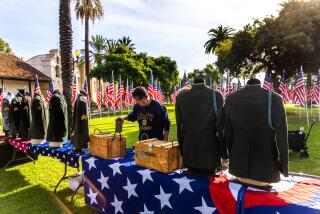Special exhibit spotlights artifacts of the soul : On display will be some of the thousands of objects left in silent tribute at the Vietnam Memorial’s Wall.
- Share via
WASHINGTON — In a place called MARS lie the dreams and despair of an American generation--labeled, catalogued, wrapped in white tissue paper, arranged in cardboard boxes and maintained at 63 degrees Fahrenheit.
MARS--the Museum of Archeological Regional Storage facility--is a central repository for the National Park Service. Built originally for NASA in Lanham, Md., it is a nondescript, 25,000-square-foot warehouse.
Inside the gunmetal-gray walls, workers wear smocks and white cotton gloves as they toil in library-like quiet. The building houses the unusual overflow of fine art and historic artifacts from Park Service properties throughout the region surrounding the nation’s capital.
It is home also to one of the most unorthodox and moving museum collections ever--the 25,000 objects left at the Vietnam Veterans Memorial since its construction a decade ago.
Even before it was finished, people left offerings at the base of the Wall, as it is known. According to legend, the first memento was left early one morning by a man wearing a Navy uniform. He crossed the construction fence and placed a Purple Heart in the still-wet concrete in front of the granite. The medal had been awarded posthumously to his brother, a pilot who died in Vietnam.
“That is one of the reasons we say that the memorial has a heart,” explained Duery Felton Jr., a Vietnam War veteran and curator of the Vietnam Veterans Memorial Collection.
The 10th anniversary of the Wall on Wednesday is being celebrated with an exhibit of 500 pieces of memorabilia left at the Wall. The exhibit, titled “Personal Legacy,” will be open through June 7 at the Smithsonian Institution’s National Museum of American History.
In addition, on Veterans Day, thousands of veterans will converge at the Wall for a ceremony that will be highlighted by the reading of all 58,183 names carved into its granite slabs.
The exhibits for the show have been collected twice a day by park rangers and sent to MARS. They are handled like other treasures because they are historically significant. They represent the social history of the country’s longest and most controversial war and the years since its end.
“At first blush, there are a lot of things in here that seem insignificant, but as we have matured with the collection we have come to understand them,” Felton said. “The objects represent tangible evidence of the effect of a specific historic epoch on America and international society.”
Artifacts left at the Wall range from cigarettes and Army boots to painfully personal love letters. Each, in its way, is an emotional remembrance of things lost:
* A series of baseballs, autographed by the greats of the game, left by a veteran for friends who died in Vietnam and will never again see the national pastime.
* A shaved beard in a small plastic bag, with a note bearing these words: “This is to tell my brothers on the Wall, I know you wanted to grow your beard and be able to stand among the civilians, so very tall. You never got your chance to, so the good Lord had me grow my hair and my beard, standing among the civilians, so very tall. Now I can leave it this year for all my brothers on the Wall.”
* Roughly 1,500 Purple Hearts, a like number of POW-MIA bracelets and assorted other medals.
* A leather jacket from an anonymous hitchhiker from California. Stuffed into its pockets were receipts from every hotel, restaurant and roadside store at which he stopped on his trip to see the Wall.
These offerings have been left by the survivors--the widows, parents, friends, children, lovers and others still haunted by the war. Many leave their gifts in the comfort of darkness, listening only to the Wall’s lonely silence. Others, oblivious to the sunlit faces of somber tourists reflected in the Wall’s gloss, leave their memories during the day. Although many came early in the Wall’s history, when it was still wrapped in controversy, many more have waited, perhaps to let time smooth the rough edges of their memories.
In recent years, Felton has noticed that items left at the Wall transcend the war and memorialize other struggles--against AIDS, homelessness and countless other anxieties and tragedies. They mark this monument as a unique symbol of the American conscience.


